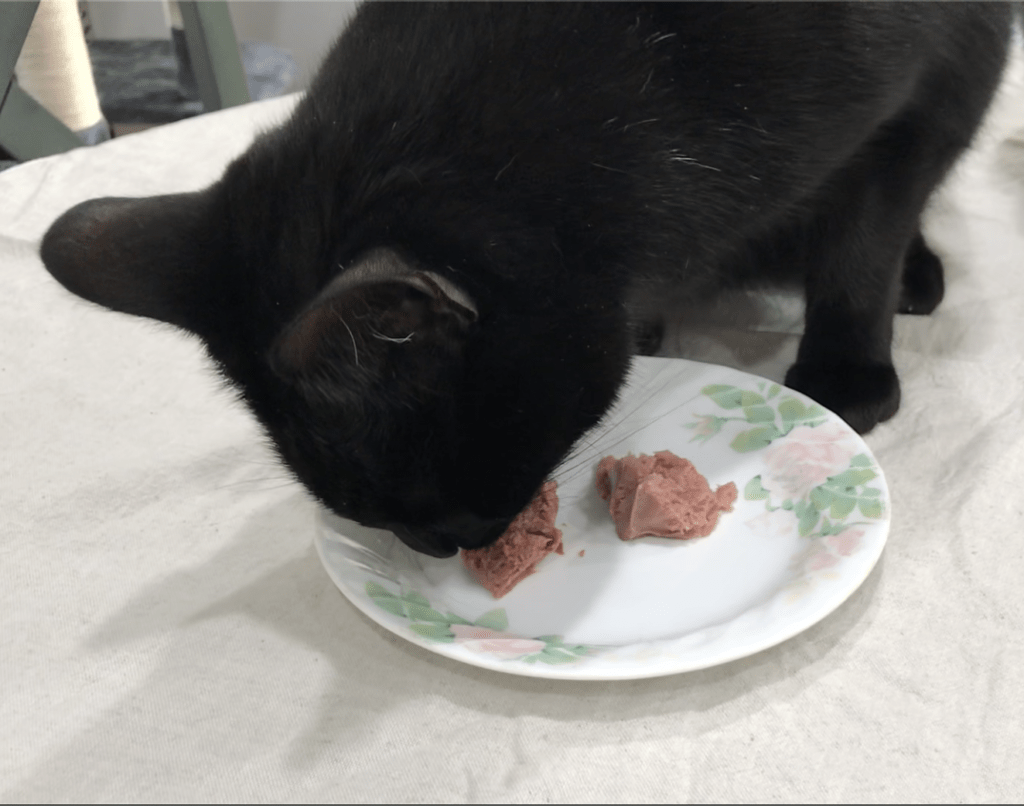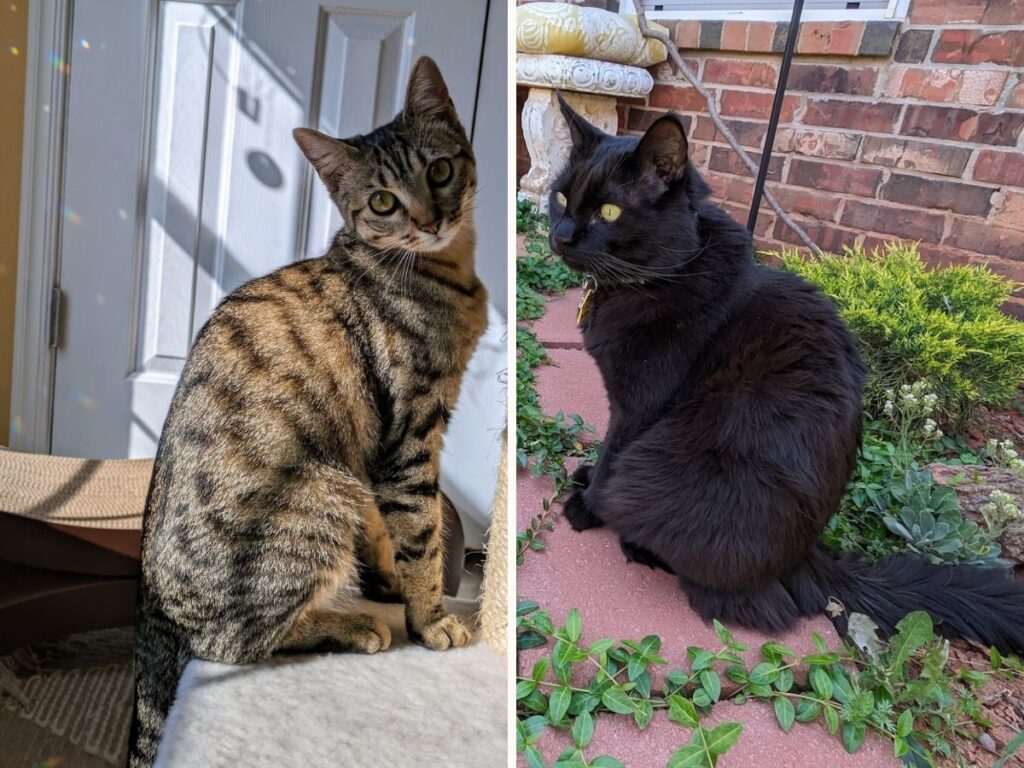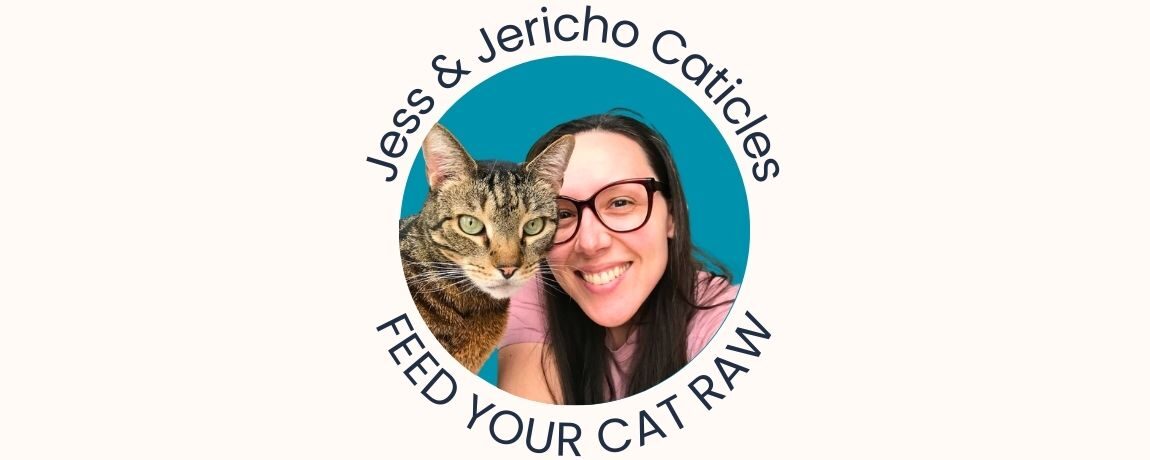Study AAFCO labeling guidelines to read cat food labels properly. The cat food label has a wealth of info if you know how to read it.
Manufacturers often use fanciful names or other techniques to emphasize a particular aspect of the product… Do not be swayed by the many marketing gimmicks or eye-catching claims.
Pet Food Labels, FDA.
If you don’t understand AAFCO labeling guidelines, you don’t understand what you’re buying.
I’ve been studying cat food since 2017. I remember how frustrating it was trying to figure it out on my own.
So I’ve boiled it down to this one post making it as simple as possible.
The TLDR of it all is that processed food is not a natural diet for our cats. That’s why I recommend raw as a pet nutritionist.
Cat food labels guide:
- AAFCO does not approve cat food
- FDA only regulates the cat food label
- How to read cat food labels
- Cat food label product name rules
- Ingredients definitions and what to avoid
- Guaranteed analysis and carb calculator
- Cat food nutritional adequacy statement
- Fancy label claims mean nothing

Disclaimer: You (and only you) are responsible for your cats. Please learn how to read cat food labels yourself. And look into the included resources.
Don’t rely on someone else to tell you what to feed your cat!
PS – If you’re ready to ditch high carb kibble for a species-appropriate raw diet, my Switch to Raw Blueprint digital magazine is for you!
My Switch to Raw Blueprint digital magazine includes my proven food transition plan, healthy treats & topper recommendations to enhance meals, best cat food brands I feed and recommend as a pet nutritionist, and so much more so you can switch your cat to a healthy premade raw diet easily and confidently.
AAFCO does not approve cat food
The Association of American Feed Control Officials (AAFCO) is a private membership organization.
Each state has its own AAFCO and cat food label rules that manufacturers must follow.
AAFCO does not approve, test, certify, or endorse cat food.
From their website:
AAFCO does not regulate, test, approve or certify pet food. It establishes model language that states and other governing bodies may adopt into law.
Understaning Pet Food, AAFCO.
So please disregard any article that says, “Best AAFCO-Approved Cat Food Brands”.
This does not exist.
Basically, AAFCO sets the guidelines for manufacturers to follow when they create and label their products.
AAFCO does not test the quality of pet food. Nor do they approve pet food.
FDA only regulates the cat food label
The US Food and Drug Administration (FDA) operates on a federal level.
The FDA works with AAFCO to make sure pet food manufacturers abide by these labeling rules.
It’s important to understand that neither of these organizations regulates pet food. They regulate the packaging label.
No one regulates the quality of your cat’s food.
This is why it’s important to learn how to read cat food labels properly.
How to read cat food labels
There are 4 crucial steps to reading cat food labels properly.
- Product name rules
- Ingredients list
- Guaranteed analysis
- Nutritional adequacy statement
And a bonus: the manufacturer.
Product name rules
The product name rule tells us how much of the named ingredient is in the product.
This could range from 0% minimum requirement to 95%.
Ingredients list
AAFCO has a wide dictionary of ingredient definitions.
There is a lot of misinformation on which ingredients are good and bad. I’ve included resources below for you to decide for yourself.
Guaranteed analysis
AAFCO does not require carbs on the guaranteed analysis.
However, you will use these numbers to calculate this yourself (carb calculator included below).
Additionally, you must convert numbers to a dry matter basis to compare foods properly (dry matter calculator included below).
Nutritional adequacy statement
The nutritional adequacy statement tells you if the product is complete and balanced. And for which life stages.
Manufacturer
I’d also suggest researching the manufacturer.
Many of the cat food brands on the shelf are actually produced by the same multi-million dollar manufacturers that produce junk food for humans.
So if their human food isn’t healthy…
Why would their pet food be healthy?
Cat food label product name rules
You must learn the product name rules. Rather than relying on fancy claims and pretty pictures.
By the way, these rules apply to cat treats as well.
Product name rules
Simple cat food name = 95% minimum
This product would have between 95-100% of the named ingredient.
- Example: “Chicken Delights Cat Food” = between 95-100% chicken.
Very few of these products exist. Especially if you’re looking for complete and balanced food.
“Recipe” in the name = 25% minimum
Other descriptive words under this rule include dinner, platter, entree, feast, nuggets, recipe, etc.
These products would have between 25-94.9% of the named ingredient.
- Example: “Paw Lickin’ Chicken Cat Food Dinner” = between 25-94.9% chicken.
That composition is combined if there are two named ingredients.
- Example: “Chicken and Rice Recipe” = between 25-94.9% chicken and rice combined.
Ideally, you would feed a product that fits under this rule and only names meat-based ingredients.
“with” in the name = 3% minimum
This product would have between 3-24.9% of the named ingredient.
- Example: “Nature’s Evolutionary Diet with Chicken” = 3-24.9% chicken.
The same combination rule applies here.
“flavor” in the name = 0% minimum
Yes, that’s right. 0% minimum.
This product would have between 0-2.9% of the named ingredient.
Only enough needs to be added for the “flavor” to be detected.
- Example: “Metabolic Weight Management Chicken Flavor” = 0-2.9% chicken.
By the way, that 0% minimum chicken product is a script diet. Look it up!
And again, the combination rule applies here too. As you can see, one word changes everything.
Ingredients definitions and what to avoid
Ingredients definitions
These are the most common that people have questions about.
Meat by-products = “Secondary products produced in addition to the principal product.”
Essentially, these are leftovers from the human food industry.
Personal note: I can buy all sorts of “by-products” at my local grocery store. Pig tails, cow feet, turkey necks, pork back fat, chicken necks, an entire lamb head, an entire rabbit, chicken feet, lamb tongue, etc. So what type of leftovers are going in pet food?
Meat and bone meal = a rendered by-product.
4-D meats = dead, dying, diseased, or disabled. Allowed in cat food as long as these ingredients are rendered.
What ingredients are not good in cat food?
There are many ingredients in cat food to avoid.
The most common ingredients that are no good include:
- Mystery meats
- Rendered meats
- Grain
- Corn
- Soy
- Rice
- Wheat
- Sugar
- Chemical preservatives
- Thickening agents
- Colors
- Palatants
Basically, unspecified meats, carbs, fillers, starches, and anything that you don’t understand. Ingredients should be easy to read and specific meat-based foods that you can recognize.
What are mystery and rendered meats in cat food?
Avoid mystery meats and rendered meats because this could literally be any type of meat.
Renderers annually convert 47 billion pounds or more of raw animal materials into approximately 18 billion pounds of products. Sources for these materials include meat slaughtering and processing plants (the primary one); dead animals from farms, ranches, feedlots, marketing barns, animal shelters, and other facilities; and fats, grease, and other food waste from restaurants and stores.
Animal Rendering Economics and Policy, CRS Report for Congress.
Examples of mystery meat and rendered meat:
- Meat by-products
- Poultry by-products
- Meat and bone meal
- Natural liver flavor
- Fish meal
The best cat food brands list the exact sources of their meat ingredients.
Examples of exact sources of meat ingredients:
- Turkey thigh
- Beef kidney
- Ground lamb bone
- Chicken liver
- Salmon oil
Do you see the difference?
Think about it like this…
Why would some cat food brands list the exact meat sources and others list mystery meats instead?
Why should I avoid grains, corn, wheat, soy, etc.?
These products are not part of the cat’s natural diet.
The only plant material a cat would consume in the wild is predigested food in the stomach contents of prey. Or nibbling on grasses here and there to relieve GI issues.
This is less than 10% of the overall diet.
These ingredients are fillers and can contribute to weight gain, diabetes, allergies, arthritis, and more.
Why should I avoid chemical preservatives, colors, and thickening agents?
Many of these ingredients can cause serious health issues like cancer, weight gain, GI upset, and more.
Some are also used as mold inhibitors and to cover up rancid meat.
Preservatives include BHA, BHT, ethoxyquin, sodium tripolyphosphate, propylene glycol, and the list goes on.
Colors include yellow 5, yellow 6, red 40, blue 2, red 3, and the list goes on.
Thickening agents include all the gums, carrageenan, starch, and the list goes on.
Please read AAFCO FAQ, worst pet food ingredients, and CRS Report for Congress on animal rendering for more details. Always do your own research!
What are palatants?
Flavor enhancer palatants are additives that pet food manufacturers use to make cat food more enticing and palatable. So that your cat eats more of it.
Commercial cat food is low in meat-based protein and high in grains and carbs.
Pet food manufacturers know that cats are not grain and carb eaters by choice. So they have to spray palatants on the food.
Again, to make your cat eat more of it so it’s actually nutritious.
Guaranteed analysis and carb calculator
AAFCO only requires crude protein, fat, fiber, and moisture for the guaranteed analysis.
Sometimes the manufacturer includes ash, vitamins and minerals, fatty acids, and other nutrients.
But carbs are never included. So we have to do that maths.
Carb calculator for cat food
AAFCO does not require carbohydrates on the guaranteed analysis.
Further proof that carbs are not essential to the cat’s diet!
Use the calculator below to find the carb amount in your cat’s food on a dry matter basis.
How many carbs are too much?
Ideally, your cat’s food would have fewer than 10% carbs on a dry matter basis.
Fewer than 10% is ideal because this matches the cat’s natural diet.
Always convert GA numbers to a dry matter basis
Kibble and wet/raw foods vary significantly in moisture content.
So you must convert protein and fat to a dry matter basis to compare cat foods properly. Basically, remove the moisture.
Use the dry matter conversion calculator below.
What is an ideal guaranteed analysis?
An ideal guaranteed analysis would match what a mouse provides.
Including moisture:
- 18.25% protein
- 7.72% fat
- 0.0% fiber
- 67.3% moisture
- 3.86% ash
Dry matter:
- 55.8% protein
- 23.6% fat
Notice that the moisture content is high. And fat content is around half the protein content.
Ash = minerals.
Important: protein and fat from mice are strictly meat-based.
Many manufacturers use things like grains, legumes, and other plant-based ingredients to bump up the protein content.
This is why it’s important to use product name rules, ingredients list, and the guaranteed analysis together when comparing cat foods.
You cannot rely solely on one of these.
By the way, yes, the cat would consume the stomach contents of prey and perhaps some grasses. But this is a very small % of the overall diet.
Cat food nutritional adequacy statement
The nutritional adequacy statement tells us if the food is complete and balanced. And for which life stages.
Complete and balanced
This product is complete and balanced as a standalone meal. No supplements are necessary.
Example:
- “Brand name” is formulated to meet the nutritional levels established by the AAFCO Cat Food Nutrient Profiles for “x life stage”.
All life stages = seniors, adults, and kittens.
Maintenance = adult cats only.
Growth = kittens only.
Intermittent or supplemental feeding
This is more of a food topper and/or treat. It does not provide complete and balanced nutrition as a standalone meal.
Example:
- “Brand name” is intended for intermittent or supplemental feeding only.
These products must be added to a complete and balanced diet. Do not add more than 10% of the overall diet.
For example, let’s say your cat eats 4 ounces of food daily.
The max amount of food topper/treat that you would feed is 0.4 ounces.
Remember to remove equal parts of the main food so you do not overfeed your cat.
Fancy label claims mean nothing
Even the FDA says that manufacturers use fanciful claims and marketing gimmicks.
This is to distract you from the labeling rules that actually matter.
These are the most common fancy label claims you will see.
Premium
Premium is completely unregulated. AAFCO has no official definition for this word.
Unlike natural and organic, “premium” is a totally unregulated term in feed law. Whereas premium gasoline must meet higher octane standards than regular gasoline, premium pet food doesn’t have special requirements that differ from any other pet food.
AAFCO FAQ.
Basically, manufacturers use this word to make you think the product is of better quality.
But AAFCO clearly states this product is no different than any other product.
Natural
There was no definition for natural in the past. But AAFCO has added a definition since many manufacturers use this claim.
Natural is a feed or feed ingredient derived solely from plant, animal or mined sources.
AAFCO Natural.
So basically 4-D rendered meats are considered natural because they are derived from an animal.
Organic
AAFCO relies on the USDA for this label claim.
Certified organic foods will display a USDA organic seal and must be made of at least 95% organic ingredients.
AAFCO Organic.
There are very few USDA-certified organic cat food brands. And I personally feel other cat food brands are still better than these. There are still high amounts of carbs in the USDA-organic brands.
Human-grade
AAFCO relies on the FDA and USDA for this claim.
Edible is a standard; human-grade is not. For a product to be deemed edible for humans, all ingredients must be human edible and the product must be manufactured, packed and held in accordance with federal regulations.
AAFCO Human Grade.
Basically, human-grade cat food must contain human-grade quality ingredients and is manufactured in a human-food production facility.
Grain-free
Grain-free on the label may mean free from grains. However, there are plenty of starchy ingredients that still contribute to the carbohydrate amount.
Potatoes, legumes, chickpeas, peas, lentils, etc. These are not grains. But they are carb sources and not appropriate for cats.
Don’t rely on these fancy claims!
By the way, I understand this is heavy stuff. So I made a satirical cat food commercial to cool things down.
But my cat is too picky to eat healthy food
Sandra had two kibble-addicted cats. Dirk is older and started to gain weight. Avery was young and healthy, but she had very picky eating habits.
Dirk had trouble jumping to his favorite spots, and Sandra started to worry that he would develop diabetes. And she didn’t want Avery to be a picky cat her whole life!
So Sandra started researching about cat food.

Sandra thought wet food would help because it is healthier than dry food.
But then she discovered raw feeding, and “it all started to make sense! This is what they eat in the wild, and would make them feel their best!!!”
She was excited to try raw, but she knew so little about how to transition them to this diet. And she didn’t know what to give them in the quantities they needed to be healthy.
Then Sandra found me and my course. She became a course member, and she followed my signature PURR blueprint.
My signature PURR blueprint works with your cat’s natural instincts. So you can focus on having fun with your cat instead of feeling stressed and overwhelmed dealing with a picky cat.
Sandra said, “This was such an indispensable tool. It eliminated any fears, or questions I had about the transition, making everything feasible, easy to understand and convenient.”
And now Dirk and Avery (previously two kibble-addicted cats) enjoy a lightly cooked homemade diet! Sandra doesn’t worry about them not getting the nutrients they need. She’s confident that what she’s feeding is the best.
On top of that, Dirk lost weight naturally (no starving) and he’s more energetic and playful.
Sandra felt close to her cats before starting this journey. But her connection and bond with her cats is much stronger now than it was before.

Sandra and her cats have shown us that our cats need more real, fresh food. Processed foods are inconsistent and cause more problems than it’s worth.
But healthy homemade cat food gives us complete control. We control the ingredients, the quality, and how it’s made.
And it’s amazing to see the results of a healthy homemade diet!
Sandra (and hundreds of other cat parents I’ve worked with) feel more empowered to know what’s good and what should be avoided for their cats.
And their cats are healthier because of it!
Ready to switch to raw for a happier cat?
Grab my Switch to Raw Blueprint digital magazine and get the same plan that 564+ cat parents used to switch to a healthy premade raw diet easily and confidently.
